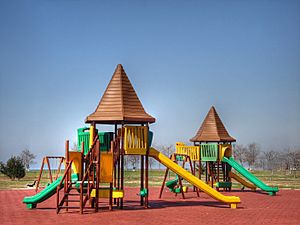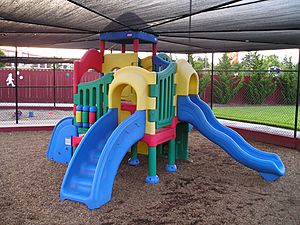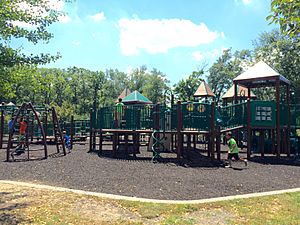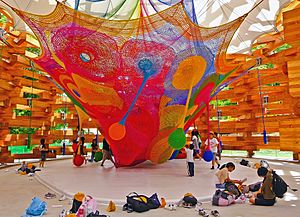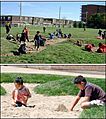Playgrounds facts for kids
A playground, playpark, or play area is a place specifically designed to enable children to play there. It is typically outdoors. While a playground is usually designed for children, some target other age groups. Berlin's Preußenpark for example is designed for people aged 70 or higher. A playground might exclude children below a certain age.
Modern playgrounds often have recreational equipment such as the seesaw, merry-go-round, swingset, slide, jungle gym, chin-up bars, sandbox, spring rider, trapeze rings, playhouses, and mazes, many of which help children develop physical coordination, strength, and flexibility, as well as providing recreation and enjoyment and supporting social and emotional development. Common in modern playgrounds are play structures that link many different pieces of equipment.
Playgrounds often also have facilities for playing informal games of adult sports, such as a baseball diamond, a skating arena, a basketball court, or a tether ball.
Public playground equipment refers to equipment intended for use in the play areas of parks, schools, childcare facilities, institutions, multiple family dwellings, restaurants, resorts, and recreational developments, and other areas of public use.
In some parts of the United States, the term tot lot may be used.
A type of playground called a playscape is designed to provide a safe environment for play in a natural setting.
Contents
History
Through history, children played in their villages and neighbourhoods, especially in the streets and lanes near their homes.
In the 19th century, developmental psychologists such as Friedrich Fröbel proposed playgrounds as a developmental aid, or to imbue children with a sense of fair play and good manners. In Germany, a few playgrounds were erected in connection to schools, and the first purpose-built public-access playground was opened in a park in Manchester, England in 1859.
One of the first playgrounds in the United States was built in San Francisco's Golden Gate Park in 1887. In 1906 the Playground Association of America was founded and a year later Luther Gulick became president. It later became the National Recreation Association and then the National Recreation and Park Association.
In post war London the landscape architect and children’s rights campaigner Lady Allen of Hurtwood introduced and popularised the concept of the ’junk playground’ - where the equipment was constructed from the recycled junk and rubble left over from the Blitz. She campaigned for facilities for children growing up in the new high-rise developments in Britain's cities and wrote a series of illustrated books on the subject of playgrounds, and at least one book on adventure playgrounds, spaces for free creativity by children, which helped the idea spread worldwide.
Playgrounds in the Soviet Union
Playgrounds were an integral part of urban culture in the USSR. In the 1970s and 1980s, there were playgrounds in almost every park in many Soviet cities. Playground apparatus was reasonably standard all over the country; most of them consisted of metallic bars with relatively few wooden parts, and were manufactured in state-owned factories. Some of the most common constructions were the carousel, sphere, seesaw, rocket, bridge, etc.
Design
Playground design is influenced by the intended purpose and audience. Separate play areas might be offered to accommodate very young children. Single, large, open parks tend to not to be used by older schoolgirls or less aggressive children, because there is little opportunity for them to escape more aggressive children. By contrast, a park that offers multiple play areas is used equally by boys and girls.
Effects on child development
Professionals recognize that the social skills that children develop on the playground often become lifelong skill sets that are carried forward into their adulthood. Independent research concludes that playgrounds are among the most important environments for children outside the home. Most forms of play are essential for healthy development, but free, spontaneous play—the kind that occurs on playgrounds—is the most beneficial type of play.
Exciting, engaging and challenging playground equipment is important to keep children happy while still developing their learning abilities. These should be developed in order to suit different groups of children for different stages of learning, such as specialist playground equipment for nursery & pre-school children teaching them basic numeracy & vocabulary, to building a child's creativity and imagination with role play panels or puzzles.
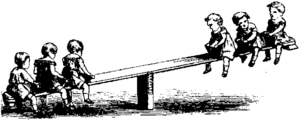
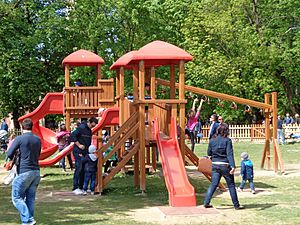
For many children, it is their favorite time of day when they get to be on the playground for free time or recess. It acts as a release for them from the pressures of learning during the day. They know that time on the playground is their own time.
A type of playground called a playscape can provide children with the necessary feeling of ownership that Moore describes above. Playscapes can also provide parents with the assurance of their child's safety and wellbeing, which may not be prevalent in an open field or wooded area.
Images for kids
-
A playground under construction in Ystad, Sweden in 2016
-
Playground at Käpylä sports park in Pasila, Helsinki, Finland
-
Playground in Yonkers, New York
-
The Royal Oak, Monmouth playground
-
Thematic playground with agricultural machine
-
The Wonder World play area at the departure lounge of Suvarnabhumi International Airport, Bangkok
-
The playground at Fermilab includes a bubble chamber model and a path resembling that followed by protons in a collider
-
Jacques-Laurent Agasse: The Playground, 1830
-
A wooden castle at playground in Rakvere, Estonia
-
Playground in Ystad, Sweden in 2019. The colorful surface is soft rubber asphalt.
See also
 In Spanish: Espacio de recreación para niños
In Spanish: Espacio de recreación para niños


